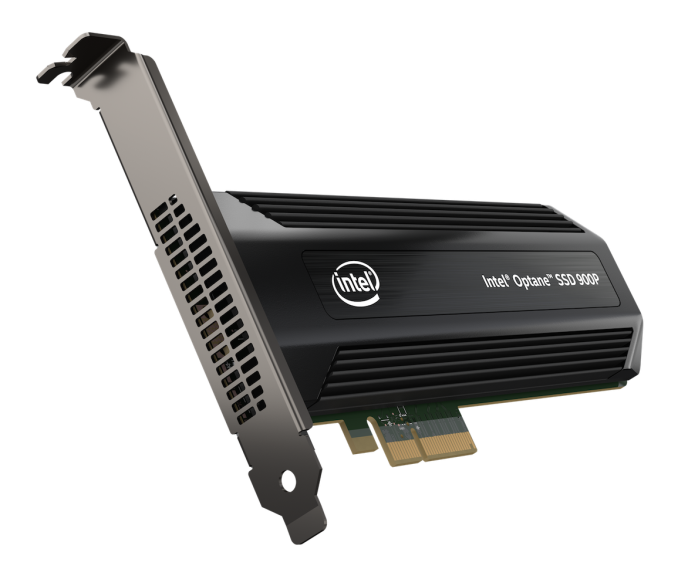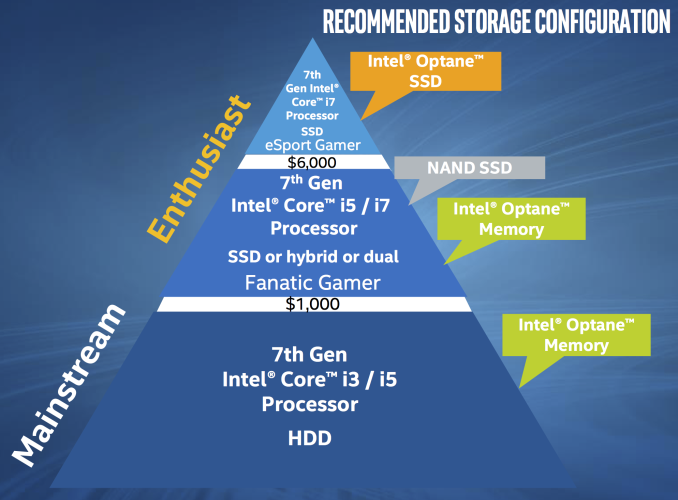The Intel Optane SSD 900P 280GB Review
by Billy Tallis on October 27, 2017 9:30 AM EST
Whenever Intel develops a new generation of SSDs based entirely on in-house technology, the result is usually a product that turns heads. Several times, Intel has set a new standard for SSD performance, starting with its original X25-M. Their most recent shake-up of the consumer SSD market was the Intel SSD 750, the first consumer NVMe SSD. Such significant releases don't happen every year, and in the intervening years Intel's competitors always catch up and surpass Intel.
However this year's revolution from Intel will be very hard for the competition to match anytime soon. All of Intel's previous record-setting SSDs have relied on the drive's controller to stand out from the crowd. This time, Intel's advantage comes from the storage medium: its 3D XPoint memory technology, a new nonvolatile memory that offers much higher performance than flash memory.
The Intel Optane SSD 900P
The new Intel Optane SSD 900P is a premium NVMe PCIe SSD offering the highest level of performance, with a moderate capacity. The Optane SSD 900P is intended for high-end desktop systems and workstations with very disk-heavy workloads. The Optane SSD 900P isn't for everyone and won't be displacing any existing products - it exists alone in a new product tier, with prices that are more than twice what the fastest flash memory based SSDs are selling for.
Optane is Intel's brand name for products featuring 3D XPoint memory. The Intel Optane SSD 900P is actually the third Optane product to be released, but it's the first family member to go after the high end consumer market segment. The Intel Optane Memory M.2 drives released earlier this year have capacities far too small for general-purpose storage use and instead have been marketed for use as a cache device to be paired with a mechanical hard drive. Intel's caching strategy works and can bring a hard drive's responsiveness up to the level of mainstream SSDs, but it has downsides. The Optane Memory caching requires a few extra steps to setup, and the caching software will only run on Intel platforms introduced this year: Kaby Lake or newer.
The Optane SSD DC P4800X is Intel's flagship enterprise SSD, and it is priced accordingly—putting it far out of reach of consumer budgets, and even with a price tag of over $1500 for 375GB it has been quite difficult to acquire. In the enterprise storage market, the P4800X has been highly sought after, but it isn't appropriate for all use cases and is not a threat to the many enterprise SSDs that prioritize capacity over performance and endurance.
The Optane SSD 900P will still cause some sticker shock for consumers expecting prices in line with M.2 PCIe SSDs, but it is acceptable for the kinds of machines that might be packing multiple GPUs or 10+ CPU cores. The Optane SSD 900P probably wouldn't be the only drive in such a system, but it would work well as a blazing fast primary storage device.
| Intel Optane SSD 900P Specifications | ||
| Capacity | 280 GB | 480 GB |
| Controller | Intel SLL3D | |
| Memory | Intel 128Gb 3D XPoint | |
| Interface | PCIe 3.0 x4 | |
| Form Factor | HHHL Add-in card or 2.5" 15mm U.2 |
HHHL Add-in card |
| Sequential Read | 2500 MB/s | |
| Sequential Write | 2000 MB/s | |
| Random Read IOPS | 550k | |
| Random Write IOPS | 500k | |
| Power Consumption | 8W Read 13W Write 14W Burst 5W Idle |
|
| Write Endurance | 10 DWPD | |
| Warranty | 5 years | |
| Recommended Price | $389 ($1.39/GB) | $599 ($1.25/GB) |
The Intel Optane SSD 900P is initially launching with 280GB and 480GB capacities. Both sizes will be available as PCIe 3.0 x4 half-height half-length add-in cards, and the 280GB model is also available as a 2.5" U.2 drive. Higher capacities may be added later, but Intel isn't promising anything yet. The sequential transfer speeds are nothing special for a NVMe SSD these days—Samsung's 960 PRO can hit much higher read speeds and slightly higher write speeds. The random read and write IOPS are far higher than any consumer SSD has offered before.
Intel's specifications for power consumption show one big reason why the Optane SSD 900P is a desktop-only product. Laptops are not equipped to supply up to 14W to a SSD, and they usually aren't equipped to cool a drive that idles at 5W instead of 50mW. The level of performance offered by the Optane SSD 900P cannot currently fit within the power budget or space constraints of a M.2 card.
The five year warranty Intel offers is typical for a high-end SSD in today's market, but doesn't compare to the 10 year warranty that Samsung's flagship 850 PRO SATA SSD offers. On the other hand, the 10 drive writes per day write endurance rating is far higher than most consumer SSDs get; 0.3 DWPD is more typical.
The Intel Optane SSD 900P starts shipping worldwide today, and here is our review of the 280GB version.











205 Comments
View All Comments
dbartley - Friday, November 3, 2017 - link
This guy is just a troll and a clown.ddriver - how many Optane reviews in the past 6 months have you commented on making the same arguments? I have seen you on at least 3 other sites making the same nonsensical argument about SLC SSDs. How many times has it been communicated to you that the "1000x" claim is based on the theoretical performance of the 3d Xpoint technology, not the performance of the first rollout of the product.
Trust me, a good troll is fun every once in a while, but dude get a life.
royrkval - Thursday, December 7, 2017 - link
When a thread is blocking on IO it shows up as 100% utilized.Aymincendiary1 - Tuesday, May 8, 2018 - link
Anybody know how to get Windows to recognize this drive as a system drive? I get an error from Windows saying it cannot install onto this partition - I have 260 GB of unpartitioned space available. It is not anything in the motherboard as i already called ASUS on this issue for thier WS x299 PRO/SE board. I didn't have this problem three years ago with Intel's HHHL NVMe drive. Windows 10 Preview as well as a licensed copy installed right away with no fuss.extide - Friday, October 27, 2017 - link
Well, damn that thing is fast! I want one!Flunk - Friday, October 27, 2017 - link
Wow, after all the talk about the price I was expecting $1000+ for the 480GB. The pricing on this is definitely on the money and the performance is clearly on a whole new level.But... in most client loads you'll never see it. I'd probably buy one anyway, but there is a good argument to be made just to save some cash and get the Samsung 960 PRO, which is by far the best consumer flash drive currently available.
extide - Friday, October 27, 2017 - link
I agree, the price is actually pretty decent. It's ~ 1/2 the price per gig than the first SSD I bought years ago.AnnonymousCoward - Saturday, October 28, 2017 - link
WTF are you guys talking about. The 960 Pro is 2x the cost of an MX300! Probably worse reliability too, based on the "They're all dead" SSD review. I don't know why you guys and the author are so hung up on the stupid 960 Pro, a serious ripoff (unless you're a part of the 0.1% of users who would use it in a way to see superior performance).mapesdhs - Tuesday, October 31, 2017 - link
#include <troll.h>AnnonymousCoward - Sunday, November 12, 2017 - link
Again, WTF. The above 2 posters said the 960 PRO is a decent price and "by far the best consumer flash drive currently available". They are wrong, as it's 2x the cost of drives that perform the same. This is worth pointing out. That doesn't make me a troll. The 2 posters should thank me for the information. Wise people like information.BrokenCrayons - Friday, October 27, 2017 - link
Optane's first consumer storage drive looks very promising. That endurance is crazy impressive and is the change the industry needs to get us moving in a better direction than NAND. The prices are reasonable for the capacity and performance, but I'd like to see reductions in power consumption and (probably) heat output so its realistic to get 3D XPoint inside laptops.